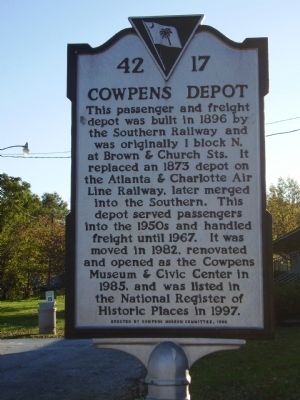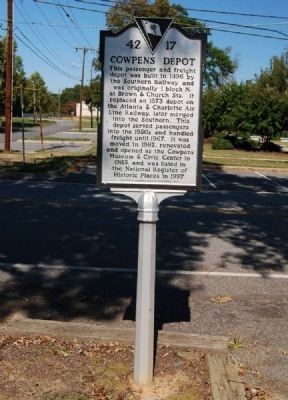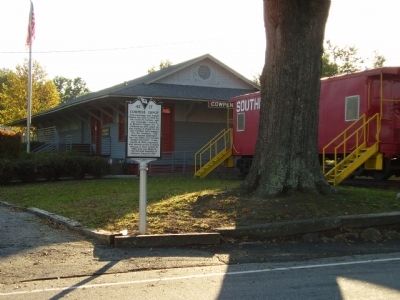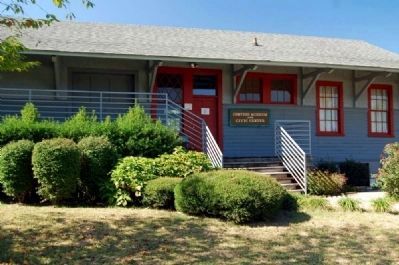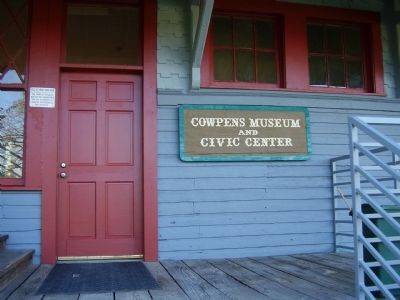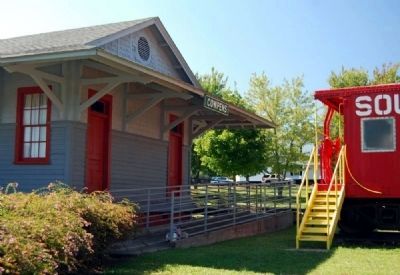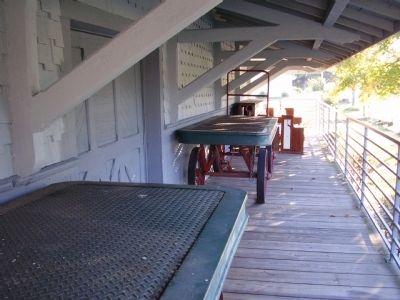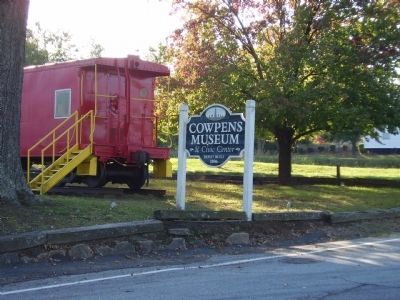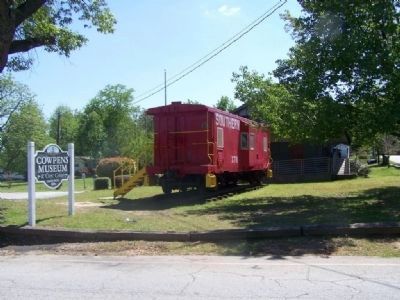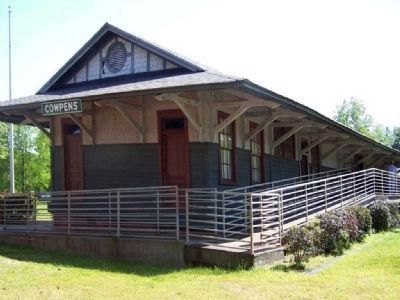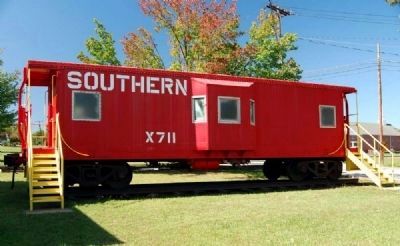Cowpens in Spartanburg County, South Carolina — The American South (South Atlantic)
Cowpens Depot
This passenger and freight depot was built in 1896 by the Southern Railway and was originally 1 block N. at Brown & Church Sts. It replaced an 1873 depot on the Atlanta & Charlotte Air Line Railway, later merged into the Southern. This depot served passengers into the 1950s and handled freight until 1967. It was moved in 1982, renovated and opened as the Cowpens Museum & Civic Center in 1985, and was listed in the National Register of Historic Places in 1997.
Erected 1998 by Cowpens Museum Committee. (Marker Number 42-17.)
Topics. This historical marker is listed in these topic lists: Notable Buildings • Railroads & Streetcars. A significant historical year for this entry is 1896.
Location. 35° 0.886′ N, 81° 48.162′ W. Marker is in Cowpens, South Carolina, in Spartanburg County. Marker is on Palmetto St. Touch for map. Marker is in this post office area: Cowpens SC 29330, United States of America. Touch for directions.
Other nearby markers. At least 8 other markers are within 6 miles of this marker, measured as the crow flies. Cowpens Veterans Memorial (within shouting distance of this marker); First Baptist Church, Cowpens (approx. ¼ mile away); Clifton World War II Memorial (approx. 2.1 miles away); Clifton Baptist Church / First Baptist Church (approx. 2.1 miles away); The Pacolet River Flood of 1903 (approx. 2.2 miles away); Welcome to Glendale Shoals (approx. 5.4 miles away); Pacolet River Heritage Preserve (approx. 6 miles away); Goucher Baptist Church (approx. 6.1 miles away). Touch for a list and map of all markers in Cowpens.
Also see . . .
1. Town of Cowpens. (Submitted on October 27, 2008, by Bill Pfingsten of Bel Air, Maryland.)
2. Cowpens, South Carolina. Cowpens is a town in Spartanburg County, South Carolina, United States. (Submitted on March 1, 2009, by Brian Scott of Anderson, South Carolina.)
3. Atlanta and Charlotte Air-Line Railway. The Atlanta and Charlotte Air Line Railway emerged from the 1877 re-organization of the Atlanta and Richmond Air Line Railway. (Submitted on March 1, 2009, by Brian Scott of Anderson, South Carolina.)
4. Southern Railway. The Southern Railway (reporting mark SOU) is a former United States railroad. (Submitted on March 1, 2009, by Brian Scott of Anderson, South Carolina.)
Additional commentary.
1. Cowpens Depot
The Cowpens Depot, at 120 Palmetto Street at the tracks of the Southern Railway and at the corner of Brown and Palmetto Streets in Cowpens, Spartanburg County, S.C., is a one-story, rectangular frame railroad station with a gable roof and a freight loading platform. Brick piers laid in cement mortar support the freight platform. The exterior wainscoted walls are a combination of weatherboard siding and wood shingles. Single transom doors lead into the interior of the building which includes an entrance hall, a large freight and express room used for civic meetings, a smaller room used as a museum, and two bathrooms. Two double freight tracked doors are along the freight platform.
The depot was moved to its present location--a block from its original site in 1982 and has since been renovated for use as a museum and civic center. The exterior wainscot walls are the original rustic tongue and groove weatherboard siding with Georgia pine sawn wood shingles. The clear heart pine brackets which supported the roof are the original. The eight foot wide pine loading platform rotted. Renovators rebuilt the platform with 2x8 treated pine lumber and added a horizontal railing for safety.
Before the repairs and renovations there were two small waiting rooms in the front of the depot for white and black passengers. The partition in the waiting rooms were removed to make one large room which now serves as a museum. The interior walls of the depot waiting rooms/museum area are original 7/8 inch beaded tongue and groove board with a three inch bard cap. The interior walls of the waiting rooms and office were wainscot with the plaster walls (three coats thick) above the four foot high bright pine beaded tongue and groove panels. The two transom entrance doors and the windows in the museum area are original to the station building. Bathrooms were relocated alongside the museum entrance.
According to the materials and construction specifications of Southern Railway Chief Engineer, the inside of the freight and express rooms were to be ceiled up 8 feet with one inch merchantable stuff sized to 7/8 inch and the flooring was to be two inches thick of clear heart yellow pine. The interior walls of the depot freight room-civic meeting room are original white pine and retain the initials of local turn of the century merchants painted on them to designate individual delivery points. The exposed pine ceiling rafters, "free from any imperfections impairing its durability" in the freight room are original. Two double freight doors 2 1/4 inches thick backed with 7/8 inch tongue and groove are also original. During the renovation the back part of the freight room was partitioned off for kitchen and storage facilities. Since the original pine floors rotted, the floors were replaced with oak hardwood flooring throughout the building.
Significance
The Cowpens Depot, built in 1896 by the Southern Railway, is significant both as an excellent example of a late nineteenth century Southern passenger and freight depot and for its association with the significance of the Southern Railway in the late nineteenth and early twentieth century growth and development of the town of Cowpens.
The Cowpens community was part of a larger agricultural community within eastern Spartanburg County and western Cherokee County. Wide expanses of land planted with cotton and various grains, large farm houses and a sparse population typified the area in the late nineteenth century. The Atlanta and Charlotte Air Line Railway built the first depot here along its line in 1873, and by 1880 the town of Cowpens was incorporated in 1880, with its charter specifying that "its corporate limits shall extend one-half mile in every direction from the railroad depot in said town." The Atlanta and Charlotte Air Line was leased by the Richmond and Danville Railroad in the 1880s and early 1890s, but by 1894 had become part of the main line of the Southern Railway.
In May 1896 the Southern Railway contracted with Joseph D. Elliott to build a new depot alongside its tracks at the corner of Brown and Church streets. The corner of Brown and Church streets was already a route for the Cowpens business district. Church Street directed the flow of people and goods to and from the depot to the mercantile stores that lined Church Street and Main Street. Facing the depot across the street was the Cowpens Hotel, a thirty room hotel with a dining room, parlor and wide porches to accommodate the needs of rail travelers. After the turn of the century,
R. R. Brown, a local resident, built the Cowpens Mill and Manufacturing Company strategically behind the depot.
The construction of the railroad line and the opening of new textile mills in the area brought some people to the town. However, according to the histories of local farming families in the White Plains, Battleground, Thicketty Creek communities, the town's population grew as an increasing number of farm boys moved into the town. They opened general mercantile stores, cafes, livery stables, drug stores, banks, saw mills, practiced medicine and preached. The town's population grew from about 300 in 1889 to more than 1300 in 1940, in large part due to the influence of the railroad.
Cotton fields on the corners of Church Street give way to the construction of stores. Cowpens became a town with significant commercial ties to outlying farm communities. Farmers in mule drawn wagons drove down the rutted dirt roads to the depot with their cotton and timber and returned to the farm with fertilizer, seed, and clothing for the family. Some farmers came with their homemade furniture or corn, wheat, cabbages and other food stuffs to trade at the increasing number of mercantile stores. By 1910, thirteen mercantile stores, five meat markets, two picture galleries, two livery stables, two barber shops and one pressing club are recorded in the town's records as having purchased business licenses. In addition the town citizens enjoyed the services of the Postal Telegraph and Cable Company which constructed telegraph lines in the town in 1902. Telephone services were available to the citizens by 1906 along with the electric power services of Electric and Manufacturing & Power Company. Thus the freight service of the railroad, along with the freight and express room of the depot, were invaluable in the commercial growth of the town.
Life in Cowpens revolved around the depot and the rail transportation system. In the years before the automobile became the major means of transportation, the folk of Cowpens used the passenger service of the railroad to commute to nearby mill villages at Converse and Clifton or to Spartanburg. Businessmen associated with the growing number of manufacturing companies in the area and traveling salesmen stopped in Cowpens to dine across the street from the depot as they traveled between Charlotte and Atlanta.
Passenger rail service to Cowpens ceased in the 1950s and freight service ceased in 1967 when the depot closed its doors to all rail service. Moore Furniture Company of Cowpens leased the depot from the Southern Railway and used it as a storage warehouse from 1967 to 1980, but by 1980 the railroad decided to demolish the deteriorating depot when the lease with Moore Furniture Company expired. The Cowpens Bicentennial Committee negotiated with Southern to preserve the building, and the railroad agreed to donate the depot to the town on the condition that it be moved from railway property. In 1982 the Town of Cowpens moved the depot one block from its original side to its present location alongside the tracks at the corner of Brown and Palmetto Streets, a move necessary to save the building and one which did not compromise its integrity.
In 1985 the Cowpens Bicentennial Committee, with the help of World War II crew members of the USS Cowpens and local contributors, began renovating the depot for service as the Cowpens Museum and Civic Center, housing memorabilia from World War II and the U.S.S. Cowpens and offering a meeting place for local clubs, families and reunions. (Source: National Register nomination form.)
— Submitted November 1, 2009, by Brian Scott of Anderson, South Carolina.
Credits. This page was last revised on November 26, 2020. It was originally submitted on October 26, 2008, by Stanley and Terrie Howard of Greer, South Carolina. This page has been viewed 1,761 times since then and 43 times this year. Last updated on May 16, 2015, by Darrell Bruggeman of Whitmire, South Carolina. Photos: 1. submitted on October 26, 2008, by Stanley and Terrie Howard of Greer, South Carolina. 2. submitted on November 1, 2009, by Brian Scott of Anderson, South Carolina. 3. submitted on October 26, 2008, by Stanley and Terrie Howard of Greer, South Carolina. 4. submitted on November 1, 2009, by Brian Scott of Anderson, South Carolina. 5. submitted on October 26, 2008, by Stanley and Terrie Howard of Greer, South Carolina. 6. submitted on November 1, 2009, by Brian Scott of Anderson, South Carolina. 7, 8. submitted on October 26, 2008, by Stanley and Terrie Howard of Greer, South Carolina. 9, 10. submitted on August 30, 2011, by Mike Stroud of Bluffton, South Carolina. 11. submitted on November 1, 2009, by Brian Scott of Anderson, South Carolina. • Bernard Fisher was the editor who published this page.
